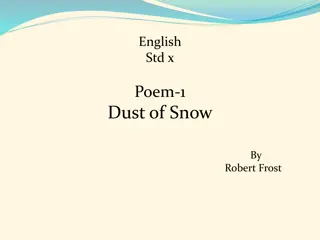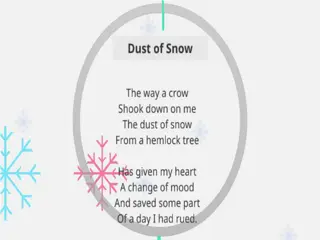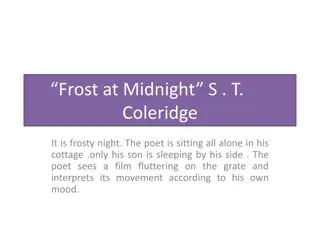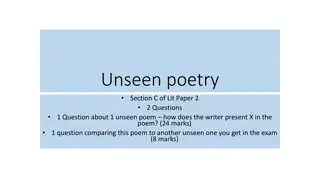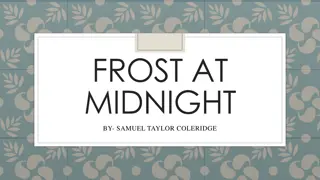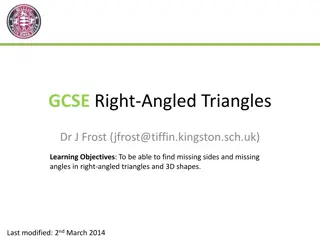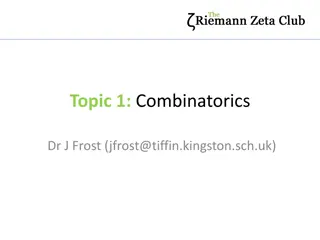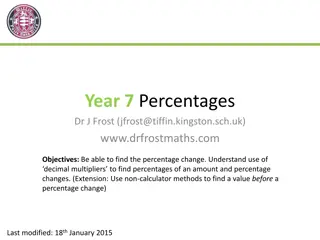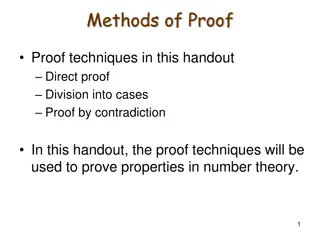Understanding Number Theory Concepts with Dr. J. Frost
Explore number theory concepts with Dr. J. Frost, including divisibility tricks, coprime numbers, and breaking down divisibility problems. Learn about key principles in number theory such as identifying if a number is divisible by certain factors and understanding coprime numbers and their relationship to least common multiples.
Download Presentation

Please find below an Image/Link to download the presentation.
The content on the website is provided AS IS for your information and personal use only. It may not be sold, licensed, or shared on other websites without obtaining consent from the author. Download presentation by click this link. If you encounter any issues during the download, it is possible that the publisher has removed the file from their server.
E N D
Presentation Transcript
Topic 3: Number Theory Dr J Frost (jfrost@tiffin.kingston.sch.uk)
Slide guidance Key to question types: IMC Intermediate Maths Challenge Frost A Frosty Special www.ukmt.org.uk The level, 1 being the easiest, 5 the hardest, will be indicated. Questions from the deep dark recesses of my head. Classic Classic IMO Intermediate Maths Olympiad Well known problems in maths. Those with high scores in the IMC qualify for the Intermediate Maths Olympiad. Those just missing out qualify for the Kangaroo. ? Any box with a ? can be clicked to reveal the answer (this works particularly well with interactive whiteboards!). Make sure you re viewing the slides in slideshow mode. For multiple choice questions (e.g. IMC), click your choice to check your answer (try below!) Question: The capital of Spain is: A: London B: Paris C: Madrid
Tip #1: Divisibility Tricks How can we tell if a number is divisible by... ? ? ? ? ? 2 Last number is even. Digits add up to multiple of 3. e.g: 1692: 1+6+9+2 = 18 3 4 Last two digits are divisible by 4. e.g. 143328 5 Last digit is 0 or 5. 6 Number is divisible by 2 and 3 (so use tests for 2 and 3). There isn t really any trick that would save time. You could double the last digit and subtract it from the remaining digits, and see if the result is divisible by 7. e.g: 2464 -> 246 8 = 238 -> 23 16 = 7. But you re only removing a digit each time, so you might as well long divide! ? ? 7 ? Last three digits divisible by 8. 8 9 Digits add up to multiple of 9. 10 Last digit 0. ? 11 When you sum odd-positioned digits and subtract even-positioned digits, the result is divisible by 11. e.g. 47949: (4 + 9 + 9) (7 + 4) = 22 11 = 11, which is divisible by 11. ? ? 12 Number divisible by 3 and by 4.
True or false? If a number is divisible by 3 and by 5, is it divisible by 15? False True If a number is divisible by 4 and by 6, is it divisible by 24? False True Take 12 for example. It s divisible by 4 and 6, but not by 24. In general, if a number is divisible by a and b, then the largest number it s guaranteed to be divisible by the Lowest Common Multiple of a and b. LCM(4,6) = 12.
Coprime If two numbers a and b share no common factors, then the numbers are said to be coprime. The following then follows: LCM(a,b) = ab Coprime? No True 2 and 3? No True 5 and 6? No True 10 and 15?
Breaking down divisibility problems We can also say that opposite: If we want to show a number is divisible by 15: ...we can show it s divisible by 3 and 5. ? But be careful. This only works if the two numbers are coprime: If we want to show a number is divisible by 8: ...we can just show it s divisible by 4 and 2? No: LCM(2,4) = 4, so a number divisible by 2 and 4 is definitely divisible by 4, but not necessarily divisible by 8. ?
Breaking down divisibility problems Key point: If we re trying to show a number is divisible by some large number, we can break down the problem if the number we re dividing by, n, has factors a, b such that n = ab and a and b are coprime, then we show that n is divisible by a and divisible by b. Similarly, if n = abc and a, b, and c are all coprime, we show it s divisible by a, b and c. If we want to show a number is divisible by 24: We can show it s divisible by 3 and 8 ? (Note, 2 and 12 wouldn t be allowed because they re not coprime. That same applies for 4 and 6) Which means we d have to show the number has the following properties: 1. Its last 3 digits are divisible by 8. 2. Its digits add up to a multiple of 3. ?
JMO Problem A number ppppqqqq is divisible by 45. What are the possible values of p? ? Answer: p = 9 or 4 It must be divisible by 5 and 9 (since 5 and 9 are coprime). If it s divisible by 5, then q = 0 or 5. If it s divisible by 9, then using the digits, 4p + 4q is a multiple of 9. [The hard bit] 4p + 4q = 4(p+q). Since this has to be a multiple of 9, and the factor of 9 obviously doesn t come from the 4, p+q must be a multiple of 9. If q = 0, then p must be 0 or 9. If q=5, then p must be 4. We ll exclude the possibility of p = 0, otherwise our number ppppqqqq would start with 0s.
Tip #2: Representing digit problems algebraically Suppose we have a 2-digit number ab . Q1: What range of values can each variable have? a: 1 to 9 ? b: 0 to 9 ? It couldn t be 0 otherwise we d have a 1-digit number. Q2: How could we represent the value (n) of the digit using a and b? e.g. If a = 7 and b = 2, we want n = 72 n = 10a + b ? Similarly, a 3-digit number abc could be represented as 100a + 10b + c
Tip #2: Representing digit problems algebraically Representing our numbers algebraically allows us to much more easily reason about the digits or determine certain properties, and allows us to represent all possible numbers. Prove that if the digits of a number sum to a multiple of 9, then then number is divisible by 9. Let s just try to do it for 3-digit numbers... Step 1: Let our number be abc . n = 100a + 10b + c Step 2: Represent the statement the digits add up to a multiple of 9 . a + b + c = 9k where k is some integer. Introducing a variable, e.g. K, allows us to represent any multiple of 9 as 9k. ? Step 3: Show that our number (n) is divisible by 9. The RHS has a factor of 9, i.e. Is divisible by 9. n = a + b + c + 99a + 9c = 9k + 99a + 9c = 9(k + 11a + c) ?
Tip #2: Representing digit problems algebraically Representing our numbers algebraically allows us to much more easily reason about the digits or determine certain properties, and allows us to represent all possible numbers. Prove that if we take a 2-digit, and produce a second number by reversing the digits, the difference is a multiple of 9. Step 1a: Let our number be ab . Step 1b: Let our reversed number be ba n1 = 10a + b n2 = 10b + a ? ? Step 2: Find the difference, and show it s divisible by 9. n1 n2 = 9a 9b ? = 9(a-b) which is divisible by 9.
Tip #2: Representing digit problems algebraically Use what you know! Question: An unfortunate number is a positive integer which is equal to 13 times the sum of its digits. Find all unfortunate numbers. I can represent the digits algebraically and form an equation. ? Answer: 117, 156, 195 I know each of my digits can be between 1 and 9 (and 0 if not the first digit) Let s try 2-digit numbers first. Algebraically: 10a + b = 13(a + b) So 3a + 12b = 0. But this gives us no solutions because one of a or b would have to be negative. Now try 3-digit numbers: 100a + 10b + c = 13(a + b + c) This simplifies to 29a = b + 4c Suppose a = 1. Then if b=1, c=7, giving 117 as a solution. We also get a=1, b=5, c=6 and a=1, b=9, c=5. If a=2 or greater, then the LHS is at least 58. But b + 4c can never be big enough, because at most b=c=9, so b+4c = 45. IMO Maclaurin Hamilton Now try 4-digit numbers: We get 329a + 29b = c + 4d after simplification. But when a is at its lowest, i.e. a=1, and b=0, the c+4d can clearly never be big enough. Cayley
Tip #3: Restricting integer solutions When you have to find all integer solutions to some equation, there s usually some way to round down your search. Solve the equation 5a ab = 9b2, where a and b are positive integers. ? Answer: a = 12, b = 2, and a = 144, b = 4. Hint: What do we know about the RHS of the equation? What do this then tell us about 5a and ab? 9b2 0, therefore ab 5a. And since a is positive, then dividing both sides by a gives us b 5. This means we only need to try b = 1, 2, 3, 4 and 5! IMO If we sub in b = 1, we get 4a = 9, for which there s no integer solution. Continuing with possible b, we eventually find all our solutions. Maclaurin In general, look out for things that are squared, as we know their value must be at least 0 (nonnegative). Hamilton Cayley
Tip #4: Dealing with remainders If x divided by y gives a remainder of z, then x z is divisible by y. For example, consider that 53 divided by 10 gives a remainder of 3. Then obviously 53 3 = 50 is divisible by 10. Question: When 144 is divided by the positive integer n, the remainder is 11. When 220 is divided by the positive integer n, the remainder is also 11. What is the value of n? A: 11 B: 15 C: 17 D: 19 E: 38 Int Kangaroo By our above rule, n divides 144 11 = 133 and 220 11 = 209. 133 = 19 x 7 and 209 = 19 x 11 So both are divisible by 19. Pink Grey
Tip #5: Using the prime factorisation Finding the prime factorisation of a number has a number of useful consequences. 360 = 23 x 32 x 5 ? We ll explore a number of these uses...
Tip #5: Using the prime factorisation Handy Use 1: Smallest multiple that s a square or cube number? 360 = 23 x 32 x 5 If the powers of each prime factor are even, then the number is a square number (known also as a perfect square ). For example 24 x 32 x 52 = (22 x 3 x 5)2. So the smallest number we need to multiply by to get a square is 2 x 5 = 10, as we ll then have even powers. If the powers of each prime factor are multiples of three, then the number is a cube number. For example 23 x 33 x 53 = (2 x 3 x 5)3. So the smallest number we need to multiply by to get a square is 3 x 52 = 75.
Tip #5: Using the prime factorisation Handy Use 2: Number of zeros on the end? 27 x 32 x 54 Q1) How many zeros does this number have on the end? 27 x 32 x 54 = 23 x 32 x (2 x 5)4 = 23 x 32 x 104? Answer: 4. Q2) What s the last non-zero digit? Answer: Using the factors we didn t combine to make 2-5 pairs (i.e. factors of 10), we have 23 x 32 left. This is 72, so the last non-zero digit is 2. ?
Tip #5: Using the prime factorisation Handy Use 3: Number of factors? 72576 = 27 x 34 x 7 A factor can combine any number of these prime factors together. e.g. 22 x 5, or none of them (giving a factor of 1). And we can either have the 7 or not in our factor. That s 2 possibilities. We can use between 0 and 7 of the 2s to make a factor. That s 8 possibilities. So there s 8 x 5 x 2 = 80 factors Similarly, we can have between 0 and 5 threes. That s 6 possibilities.
Tip #5: Using the prime factorisation Handy Use 3: Number of factors? aq x br x cs In general, we can add 1 to each of the indices, and multiply these together to get the number of factors. So above, there would be (q+1)(r+1)(s+1) factors.
Tip #5: Using the prime factorisation Handy Use 3: Number of factors? How many factors do the following have? = 2 x 52 so 2 x 3 = 6 factors. 10100? = (2 x 5)100 = 2100 x 5100 So 1012 factors = 10201 factors. 50? ? ? 20032003? (Note: 2003 is prime) = 23 x 52 so 4 x 3 = 12 factors. 200? ? This is already prime- factorised, so there s 2004 factors. ?
Tip #6: Reasoning about factors We can reason about factors on each side of an equality. Example: Find all positive integer solutions for the following: (x+2)(y-2) = 15 ? Answer: Possible (x,y) pairs are (1,7), (3,5), (13, 3) The RHS is 15, so the multiplication on the LHS must be 1 x 15, 3 x 5, 5 x 3 or 15 x 1. So for the second of these for example, x+2=3 and y-2=5, so x=1 and y=7. This leads to all the solutions above.
Tip #6: Reasoning about factors You should try to form an equation where you can reason about factors in this way. Question: A particular four-digit number N is such that: (a) The sum of N and 74 is a square; and (b) The difference between N and 15 is also a square. What is the number N? Step 1: Represent algebraically: Step 3: Reason about factors N + 74 = q2 N 15 = r2 Conveniently 89 is prime, and since q+r is greater than q-r, then q + r = 89 and q r = 1. Solving these simultaneous equations gives us q = 45 and r = 44. Using one of the original equations: N = q2 74 = 452 74 = 1951. ? ? Step 2: Combine equations in some useful way. Perhaps if I subtract the second from the first, then I ll get rid of N, and have the difference of two squares on the RHS! 89 = (q + r)(q r) ? Source: Hamilton Paper
Tip #6: Reasoning about factors You should try to form an equation where you can reason about factors in this way. Question: Show that the following equation has no integer solutions: 1 1 5 x y 11 + = (Source: Maclaurin) Questions of this form are quite common, particularly in the Senior Maths Challenge/Olympiad. And the approach is always quite similar... Step 1: It s usually a good strategy in algebra to get rid of fractions: so multiply through by the dominators. 11x + 11y = 5xy ?
Tip #6: Reasoning about factors You should try to form an equation where you can reason about factors in this way. 11x + 11y = 5xy Step 2: Try to get the equation in the form (ax - b)(ay - c) = d This is a bit on the fiddly side but becomes easier with practice. Note that (x + 1)(y + 1) = xy + x + y + 1 Similarly (ax - b)(ay - c) = a2xy - acx - aby + b2 So initially put the equation in the form 5xy 11x 11y = 0 Looking at the form above, it would seem to help to multiply by the coefficient of xy (i.e. 5), giving 25xy 55x 55y = 0 This allows us to factorise as (5x 11)(5y 11) 121 = 0. The -121 is because we want to cancel out the +121 the results from the expansion of (5x 11)(5y 11). So (5x 11)(5y 11) = 121
Tip #6: Reasoning about factors You should try to form an equation where you can reason about factors in this way. (5x 11)(5y 11) = 121 Step 3: Now consider possible factor pairs of the RHS as before. Since the RHS is 121 = 112, then the left hand brackets must be 1 121 or 11 11 or 121 1 or -1 -121, etc. (don t forget the negative values!) If 5x 11 = 1, then x is not an integer. If 5x 11 = 11, then x is not an integer. If 5x 11 = -1, then x = 2, but 5y 11 = -121, where y is not an integer. (And for the remaining three cases, there is no pair of positive integer solutions for x and y.)
Tip #6: Reasoning about factors Let s practice! Put in the form (ax b)(ay c) = d -5 and -7 swap positions. Use the 4 from 4xy (-5) x (-7) 7 5 x y 4xy 5x 7y = 0 + = 4 (4x 7)(4y 5) = 35 1 1 x y xy x y = 0 + = 1 (x 1)(y 1) = 1 ? ? 3 3 x y 2xy 3x 3y = 0 ? ? + = 2 (2x 3)(2y 3) = 9 1 2 3 x y 19 (3x - 19)(3y 38) = 722 ? 3xy 38x 19y = 0 ? + = In general, this technique is helpful whenever we have a mixture of variables both individually and as their product, e.g. x, y and xy, and we wish to factorise to aid us in some way.. Now for each of these, try to find integer solutions for x and y! (if any)




